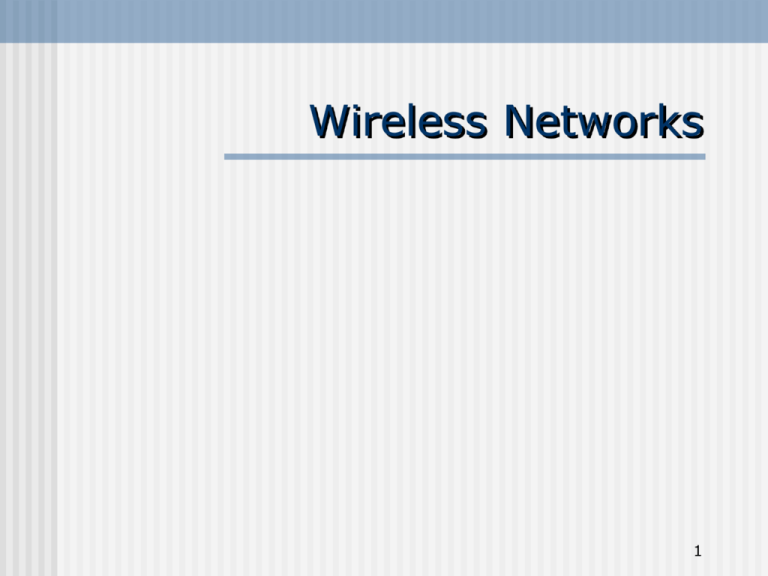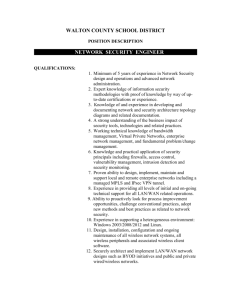wirelessnetwork
advertisement

Wireless Networks 1 Wireless Networking: Intangible Media Depend on transmission at some kind of electromagnetic frequency, typically radio frequency, through the atmosphere to carry data transmissions from one networked device to another Appear most frequently in conjunction with wired networks 2 Capabilities of the Wireless World Create temporary connections to existing wired networks Establish back-up or contingency connectivity for existing wired networks Extend a network’s span beyond the reach of wire- or fiber-optic-based cabling Permit certain users to roam with their machines, within certain limits 3 Commercial Applications for Wireless Networking Ready access to data for mobile professionals Delivery of network access into isolated facilities Access in environments in which layout and settings change constantly Improved customer services in busy areas, e.g, 70% of Starbuck’s 4,000 stores were equipped with wireless LAN by 2003 Network connectivity in facilities where in-wall wiring would be impossible to install or prohibitively expensive 4 Cities with Wireless Internet Seoul Taipei Singapore Hong Kong (being planned) Mexico City (being planned) Some cities in USA are given free wireless internet access (see http://ilovefreewifi.com/) 5 Questions What are the major challenges to wireless networking when compared to wired networking? 6 Types of Wireless Networks Local area networks (LANs) Extended LANs Mobile computing Worldwide wireless LAN shipments is expected to grow from 1.7 million in 1999 to almost 12 million by 2004 7 Wireless LAN Applications Still necessary to attach a network interface to a computer, but the interface attaches to an antenna and an emitter rather than to a cable Requires an access point device (connected to a wired network) to bridge wireless components and the wired network 8 Wireless Access Point Device 9 Wireless Access Point Devices 10 How Do WLANs Work? Sending signals through the air between devices Signal can be transmitted sometimes up to 1,000 feet Dependent on the signal nature, a signal may be able to pass through nonmetal wall and barriers WLAN cards are needed 11 Modes of communication Device-to-device interaction Access point (AP) connections to a wired LAN APs are stationary devices usually installed in a ceiling (which is analogous to a tower in a cellular phone network) 12 Wireless LAN Transmission Most common frequencies used Radio: 10 KHz to 1 GHz Microwave: 1 GHz to 500 GHz Infrared: 500 GHz to 1 THz Primary technologies used Infrared Laser Narrowband, single-frequency radio Spread-spectrum radio (most common) 13 Broadcast Medium Principles Inverse relationship between frequency and distance (high frequency short distance) (when transmission power is ignored) Direct relationship between frequency and data transfer rate and bandwidth Higher-frequency technologies often use tight-beam broadcasts and require a clear line of sight between sender and receiver to ensure correct delivery 14 Infrared LAN Technologies Use infrared light beams to send signals between pairs of devices Have high frequency and bandwidth; work well for LAN applications Require a line of sight between sender and receiver Less reliable than the radio technologies 15 Kinds of Infrared LANs Line-of-sight networks Reflective wireless networks Via a central hub (or transceiver) Scatter infrared networks Bounce transmission off walls and ceilings Distance limited to ~30m Tend to have a slow transmission Broadband optical telepoint networks Fastest of its kind 16 Laser-based LAN Technologies Require a clear line of sight between sender and receiver Devices are subject to many of the same limitations as infrared but are not as subject to interference from visible light sources; however, laser is much more sensitive to outside disturbances than infrared 17 Narrow-band, Single-frequency Radio LAN Technologies Use low-powered, two-way radio communications Require no line-of-sight between sender and receiver Broadcast range is 5000 square meters and cannot go through steel or load-bearing walls 18 Narrow-band, Single-frequency Wireless LAN Characteristics 19 High-powered, Singlefrequency LAN Characteristics 20 Spread-spectrum LAN Technologies Address weaknesses of single-frequency communications Use multiple frequencies simultaneously; improve reliability and reduce susceptibility to interference Make eavesdropping more difficult Two main kinds Frequency-hopping Direct-sequence modulation 21 Spread-spectrum LAN Characteristics 22 Frequency-hopping Spreadspectrum Frequency is divided into hops Blocks of data are transmitted on different frequencies known to the intended receiver. The receiver gets the signals and puts the block in the right order. Provides built-in security (but not error detection) because the frequencies hop around at undetermined times and frequencies and cannot be easily determined by potential hackers 23 Direct-sequence Modulation Breaks a message into bits and modulates each bit by a redundant bit pattern (known as chip or chipping code) before each information bit is transmitted Tends to use bandwidth inefficiently but transmissions are more reliable and secured Chip may be used for error detection and correction purpose 24 Direct-sequence Modulation Example Information bits to be transmitted 1011 Chipping code 010 Transmitted bits (modulo-2 addition) 101010101101 25 Wireless Extended LAN Technologies Wireless bridge A pair of devices, typically narrow-band and tight beam, that relay network traffic from one location to another Available using spread-spectrum radio, infrared, and laser technologies Can span distances from hundreds of meters up to 25 miles 26 Wireless Extended LAN Characteristics 27 Microwave Networking Technologies Can deliver higher transmission rates than radio-based systems Transmitters and receivers must share a common, clear line of sight Usually require FCC approval and licensing More expensive than radio systems Two types Terrestrial Satellite 28 Terrestrial Microwave Uses line-of-sight communication between pairs of Earth-based transmitters and receivers to relay information Expensive; usually positioned well above ground level 29 Terrestrial Microwave LAN/WAN Characteristics 30 Satellite Microwave Uses geosynchronous satellites to send and relay signals between sender and receiver Usually leased for an exorbitant fee 31 Satellite Microwave WAN Characteristics 32 Security issues (1/4) Adopt an encryption mechanism If possible, use Wi-Fi Protected Access (WPA) and WPA2 instead of wired Equivalent Privacy (WEP) All clients and access points are to be configured with the same key for encryption and decryption (manually as there is no key management protocol) 33 Security issues (2/4) Use a Service Set Identifier (SSID) a case-sensitive string attached to all packets on a wireless network to identify each packet as part of that network all wireless devices attempting to communicate with each other must share the same SSID never use the default SSID given by the manufacturer turn off SSID broadcasting 34 Security issues (3/4) MAC addressing filtering A list of client computers’ MAC addresses can be inputted into an Access Point so that only those computers will be allowed access. This is a good method of security but only recommended for smaller networks as there is a high rate of work involved in entering each MAC address into every Access Point. 35 Security issues (4/4) Restrict unnecessary traffic If your router is equipped with a firewall, turn it on. Change the default administrator password Protect your PC with antivirus software and apply any new system patches timely 36 Summary (1/2) Wireless networking Provides cable-free LAN access Extends span of LANs Provides WAN links Supports mobile computing needs Uses a variety of electromagnetic frequency ranges • Narrow-band and spread-spectrum radio • Microwave • Infrared • Laser transmission 37 Summary (2/2) Common security approaches Wired equivalent privacy Service set identifier MAC address filtering 38






